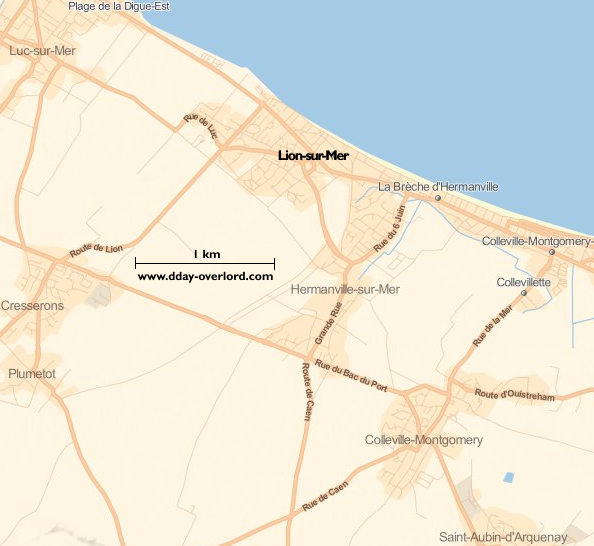Lion-sur-Mer (Calvados)
The cities of Normandy during the 1944 battles
- Liberation: June 7, 1944
- Deployed units:
![]() N°41 Royal Marine Commando, 4th Special Service Brigade, 3rd Infantry Division
N°41 Royal Marine Commando, 4th Special Service Brigade, 3rd Infantry Division
![]() 1st Battalion South Lancashire Regiment, 8th Infantry Brigade, 3rd Infantry Division
1st Battalion South Lancashire Regiment, 8th Infantry Brigade, 3rd Infantry Division
![]() 2nd Battalion Lincolnshire Regiment, 9th Infantry Brigade, 3rd Infantry Division
2nd Battalion Lincolnshire Regiment, 9th Infantry Brigade, 3rd Infantry Division
![]() 13th/18th Royal Hussars, 27th Armoured Brigade, 3rd Infantry Division
13th/18th Royal Hussars, 27th Armoured Brigade, 3rd Infantry Division
![]() I/Panzergrenadier-Regiment 192, 21. Panzer-Division
I/Panzergrenadier-Regiment 192, 21. Panzer-Division
![]() III/Grenadier-Regiment 736, 716. Infanterie-Division
III/Grenadier-Regiment 736, 716. Infanterie-Division
- History:
The commune of Lion-sur-Mer in Calvados was occupied in 1944 by the 10th company under the command of Hauptmann (captain) Heinrich Kuhtz, belonging to the Grenadier-Regiment 736 (716. Infanterie-Division). The beach is directly defended by a strongpoint located to the west of the village and coded Wn 21 which includes several shelters and ammunition bunkers, two auxiliary observatories working for the Colleville-sur-Orne battery (Wn 16) As well as a 75 mm gun, two 50 mm KWK L/60 anti-tank guns and a 81.4 mm mortar (Gr.W 34).
Given the size of the locality, the Allies do not plan to land directly in front of the commune of Lion-sur-Mer but they want to take a foot first about 500 meters further east to La Brèche d’Hermanville (where the population density is smaller) then in a second time seize the commune of Lion by a turning movement. British Navy’s No.41 Royal Marine Commando (4th Special Service Brigade) are responsible for carrying out this maneuver on D-Day. They received several missions: to seize Wn 21 strongpoint, baptized « position Trout » by the Allies, to seize the castle of the Haut-Lion supposed to contain a German Staff, to make the connection with the No.48 Royal Marine Commando in the area of Petit-Enfer, near Luc-sur-Mer, in order to connect the two areas of beaches Sword and Juno, and finally to seize the radar station of Douvres-la-Délivrande.
Before the infantry arrived on Sword Beach, the allied warships were ordered to bombard the Trout position. No.41 Royal Marine Commando (RMC), commanded by Lieutenant-Colonel T.M. Gray, landed at 8:45 am at the western end of the beach area called Queen White, which is located at the west end of Sword Beach. The British commandos are supported by Company A of the 1st Battalion South Lancashire Regiment (8th Infantry Brigade) commanded by Lieutenant R. W. Pearce (Major Harward was killed a few minutes ago) and special tanks. At 0940 hours, almost one hour after landing, the No. 41 RMC already recorded heavy losses. Nevertheless, they start their progression towards Lion-sur-Mer. Civilians gave valuable information to the British, noting that the Germans had retreated around 7 am. Gray divides his unit into two columns: one directed towards Wn 21 strongpoint (Troop P and Troop Y), the other towards the castle (Troop A and Troop B).
The Troop P illuminates the progression towards the « Trout » fulcrum, supported by the Troop Y and company A of the 1st Lancs. The first elements of the Troop P are fixed in front of the Wn 21 when three special tanks A.V.R.E. Came to support the British at 10:50 am: the latter were committed to the preparation of the assault to be carried out by the Troop Y, but in only five minutes the three tanks were destroyed by a 50 mm gun. At the same time, the Germans carried out a mortar fire on the No. 41 RMC and Captain P. T. H. Dufton, commander of the Troop Y, was killed. In the early afternoon, Troop X survivors reinforce the Troop Y.
At 4 pm, the English commandos were stationed in front of the « Trout » fulcrum and the castle, undergoing regular artillery fire on their positions. The reinforcements of the 9th Infantry Brigade landed at La Brèche allow a reorganization of the front line and the soldiers make the point before night: the No.41 RMC lost 140 soldiers (killed, wounded, disappeared or prisoners) in This first day, a loss rate close to 50%. The Allied navy bombarded the entrenched German positions at 1800 hours.
Around 7 pm, elements of the 1st battalion, Panzergrenadier-Regiment 192 and the 1st battalion, Panzer-Regiment 22 (21 Panzer-Division) managed to reconnoitre to the western outskirts of Lion-sur-Mer and A device allied until 9 pm, taking advantage of the difficulties encountered by Anglo-Canadians in linking the two Juno and Sword beaches. When British planes and planes fly over the area shortly before 9 pm as part of Operation Mallard, the Germans decide to withdraw to Caen so as not to be cut off from the rest of their units.
On June 7, 1944, after a relatively quiet night, No.41 RMC was attached to the 9th Infantry Brigade for the continuation of the fighting and, in view of its losses, was placed in support. At 3:36 pm, the 2nd Battalion Lincolnshire Regiment ascended the castle and seized it, losing a soldier during the attack and making two German prisoners: most of their opponents had withdrawn before. At 6:20 pm, the No.41 RMC started up in the direction of Luc-sur-Mer and the commandos made the junction with the troops coming from of Juno.
Lion-sur-Mer maps:

